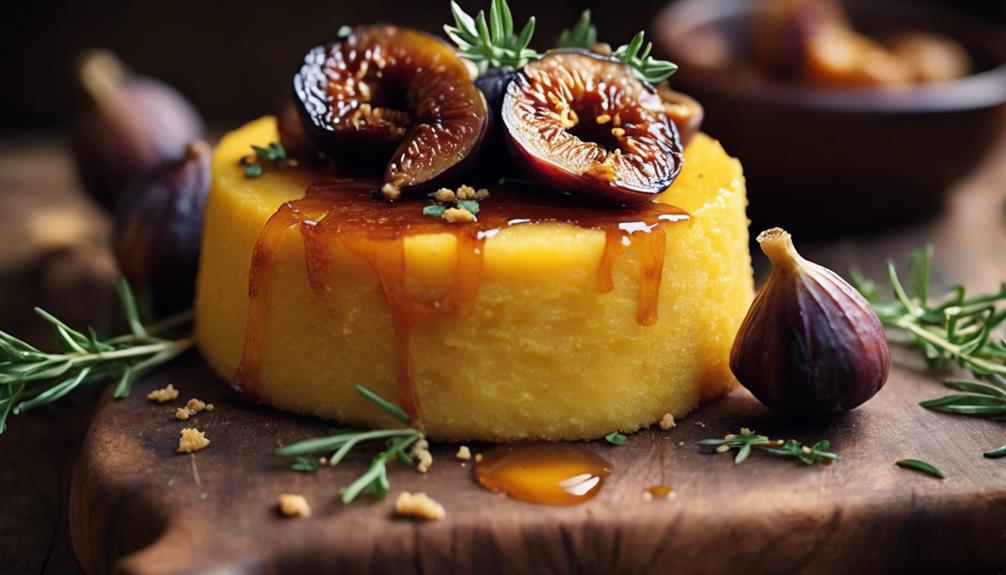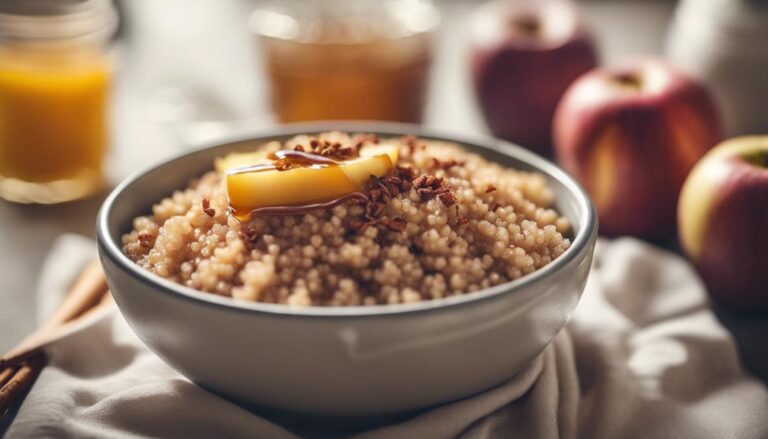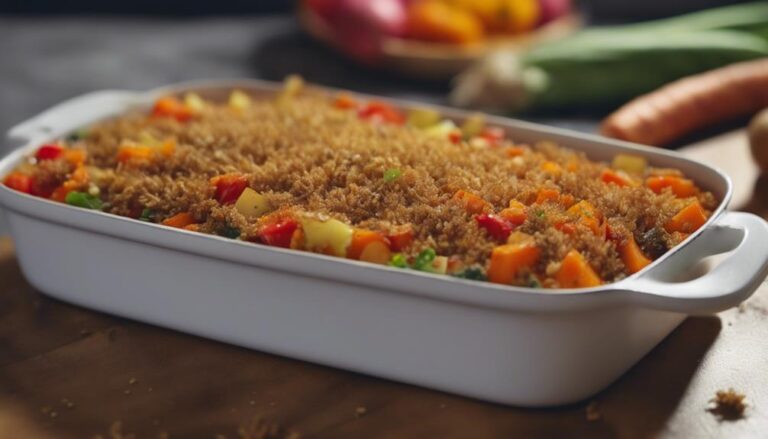Sous Vide Polenta Cake With Roasted Figs
Plunge your fork into a decadent Sous Vide Polenta Cake With Roasted Figs, where the tender cake meets caramelized sweetness for a heavenly fusion of flavors. The sous vide technique guarantees flawless cooking, resulting in a moist texture that delights your palate. Controlled water bath temperatures keep the cake just perfect without compromising moisture. The combination of flavors in this dessert is like a flawless harmony. Ready to delve into this delightful recipe further?
What You Will Learn Here
- Sous vide ensures even cooking for moist polenta cake.
- Roasted figs add caramelized sweetness.
- Controlled temperature in water bath maintains cake moisture.
- Precision cooking highlights flavor symphony.
- Combination offers delightful dessert conclusion.
Polenta Cake Origins
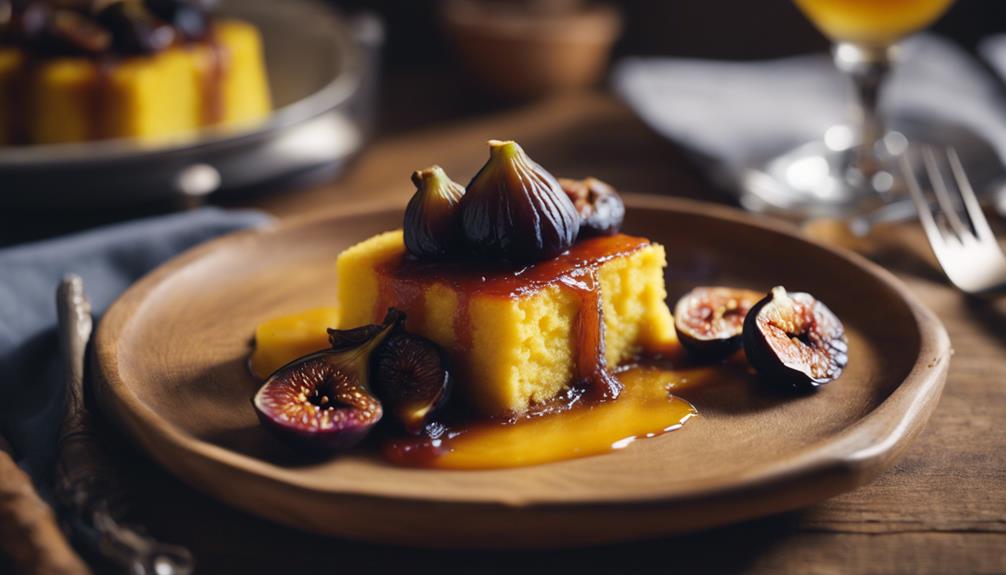
Polenta cake traces its origins to the northern Italian region of Veneto, renowned for its culinary heritage.
The traditional cake recipe boasts a distinctive blend of polenta, figs, raisins, pine nuts, and fennel seeds, creating a unique flavor palette.
As grappa, a grape pomace-based liquor, is often incorporated, the cake offers a depth of taste that evolves when served warm or at room temperature.
Historical Polenta Cake Origins
Tracing back through the culinary annals of northern Italy reveals the intriguing origins of this delectable dessert known for its distinctive blend of cornmeal, eggs, sugar, and at times, a hint of grappa.
The history of Polenta Cake is deeply rooted in the Veneto region's culinary heritage, where figs play a significant role in traditional recipes. The marriage of sweet figs with the rich, grainy texture of the cornmeal base creates a harmonious balance of flavors that has stood the test of time.
This historical dessert reflects the essence of Italian cooking practices, showcasing regional preferences and a deep connection to the land. The evolution of Polenta Cake over time highlights the adaptability of this classic dessert to incorporate various fruits, nuts, and spices, catering to personal and regional tastes.
Traditional Polenta Cake Variations
Venture further into the intricate world of traditional desserts from the Veneto region of northern Italy, where the art of crafting polenta cake takes on various flavorful forms.
In these traditional variations, ingredients like figs and fennel seeds add depth and complexity to the rich cornmeal base. The figs provide a subtle sweetness that contrasts beautifully with the earthy notes of the fennel seeds, creating a harmonious blend of flavors.
The addition of these ingredients showcases the creativity and ingenuity of Italian bakers, who've perfected the balance of sweet and savory in their desserts. Exploring these traditional polenta cake variations offers a glimpse into the culinary heritage of the Veneto region and a chance to savor the exquisite flavors of this beloved Italian treat.
Modern Polenta Cake Trends
In exploring the evolution of modern dessert trends, one encounters a fascinating intersection of creativity and tradition manifested in the innovative adaptations of traditional polenta cake recipes. Modern trends in polenta cakes have seen a resurgence in popularity due to their ability to blend traditional flavors with contemporary twists. By incorporating ingredients like grappa, figs, and fennel seeds, chefs have elevated the humble polenta cake into a sophisticated dessert option. The versatility of polenta cakes allows for experimentation with various flavors, textures, and presentations, making them a favorite among dessert enthusiasts. To showcase the modern appeal of polenta cakes, renowned sources like Bon Appetit have featured adaptations that highlight the dessert's culinary charm. Experimenting with elements like chopped figs adds a delightful contrast to the cake's texture and taste.
| Modern Polenta Cake Trends | |
|---|---|
| Grappa-infused flavors | Innovative textures |
| Figs as a key ingredient | Creative presentations |
| Fennel seed garnishes | Culinary appeal |
Key Polenta Cake Components
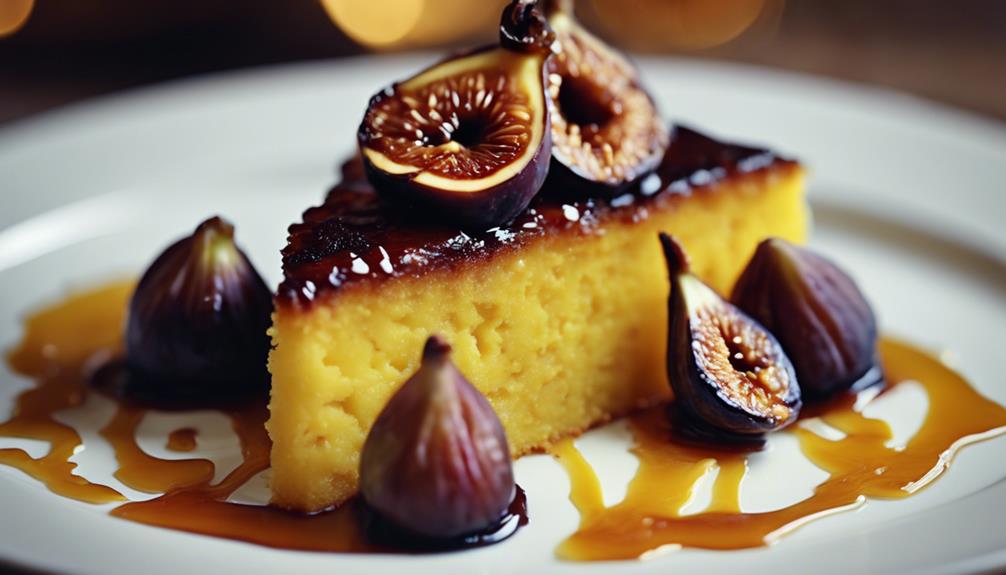
When crafting a delicious polenta cake, the key components lie in the harmonious blend of cornmeal, sugar, and a touch of finesse to elevate its texture and flavor profile. Here are three important elements to keep in mind when creating a mouthwatering polenta cake:
- Cornmeal: The foundation of any polenta cake, the quality of the cornmeal used can greatly impact the final taste and texture. Opt for a finely ground cornmeal for a smoother consistency or a coarser grind for a more rustic feel. The cornmeal brings a distinct maize flavor that sets this cake apart from traditional desserts.
- Sugar: Balancing the natural earthiness of cornmeal, sugar plays a crucial role in sweetening the cake. Whether using granulated sugar, honey, or maple syrup, the right amount is key to achieving the perfect level of sweetness without overpowering the corn flavor.
- Finesse: A delicate touch and attention to detail are essential when preparing a polenta cake. Mixing the batter until just combined, ensuring even distribution of ingredients, and baking it to perfection are all elements that require finesse to achieve a moist, tender crumb and a delightful golden crust.
Fig & Walnut Cake Recipe
When making the Fig & Walnut Polenta Cake, the ground walnuts lend a rich and nutty taste to the dessert.
Substituting anise seeds with fennel seeds can offer a similar aromatic essence to the cake.
The versatility of this cake, with its subtle sweetness, allows for creative pairings like a Walnut & Honey Glaze or a Honey-Spiced Fig Compote.
Fig & Walnut Polenta Cake
For a delectable twist on traditional polenta cake, infuse your baking with the rich flavors of figs and walnuts. The combination of fresh figs and crunchy walnuts brings a delightful contrast of sweetness and earthiness to each bite. Adding a touch of vanilla extract enhances the overall aroma and taste profile, elevating this dessert to a whole new level of indulgence. The figs provide a burst of fruity flavor, while the walnuts offer a satisfying crunch, making each slice a delightful experience for your taste buds.
- The figs add a natural sweetness that perfectly complements the nutty flavor of the walnuts.
- Vanilla extract enhances the overall richness of the cake, creating a harmonious blend of flavors.
- The texture of the walnuts in the cake provides a satisfying contrast to the softness of the polenta, creating a delightful mouthfeel.
Walnut & Honey Glaze Recipe
Shifting from the delightful Fig & Walnut Polenta Cake, let's now explore the enticing Walnut & Honey Glaze Recipe that adds a sweet and nutty finish to this charming dessert. This glaze is the perfect final touch to your fig and walnut creation, enhancing both its taste and appearance. Here are three reasons why this glaze will elevate your baking experience:
- Enhanced Flavor: The combination of honey and chopped walnuts creates a rich, sweet flavor that complements the fresh figs beautifully.
- Visual Appeal: The glossy finish of the glaze adds an attractive shine to your cake, making it even more inviting to indulge in.
- Customization Options: You can adjust the sweetness levels of the glaze or even add a hint of cinnamon for a unique twist to suit your preferences.
Honey-Spiced Fig Compote
Simmering figs with honey, cinnamon, and a blend of spices creates the lusciously sweet and spiced honey fig compote, a delectable topping for the fig and walnut polenta cake.
- As the figs gently simmer in the honey and spices, their natural sweetness intensifies, infusing the compote with a rich and indulgent flavor that perfectly complements the earthy notes of the walnut and polenta cake.
- The warm spices like cinnamon add a comforting warmth to the compote, making it a delightful addition to the dessert, especially during the colder months.
- The versatility of this honey-spiced fig compote extends beyond just being a cake topping; it can elevate a range of dishes, providing a touch of elegance and sweetness to every bite.
Baking With Polenta Flour
When baking with polenta flour, you'll notice its distinct grainy texture that can add a delightful crunch to your cakes. Balancing the polenta flour with other ingredients is essential to achieve the desired texture and taste in your final baked goods.
Experimenting with flavor pairings like figs can elevate the rustic and hearty elements that polenta flour brings to your desserts.
Polenta Flour Benefits
Baking with polenta flour introduces a distinctive texture and flavor profile to your baked goods, elevating them with a slightly gritty yet tender crumb that sets them apart from traditional options.
The incorporation of polenta flour not only adds a rustic appearance with a golden hue but also offers a gluten-free alternative for those with sensitivities.
Additionally, this flour is a nutrient-rich choice, boasting fiber, vitamins, and minerals that enhance the nutritional value of your treats.
By using polenta flour in your baking, you can create delicious alternatives to typical wheat flour recipes, adding variety and depth to your culinary creations.
Baking Tips for Polenta
To elevate your baking game with polenta flour, consider blending it with other flours like all-purpose or almond flour for improved structure and a unique texture and flavor profile in your baked goods.
When incorporating polenta flour, remember that it can add a delightful grittiness that enhances the overall eating experience of cakes, muffins, or breads. Since polenta flour has a higher liquid absorption capacity than traditional flour, adjusting the wet ingredients in your recipes may be necessary to achieve the desired consistency.
Experimenting with different ratios of polenta flour to other flours allows you to fine-tune the balance of texture and flavor in your baked treats. By combining polenta flour with complementary ingredients like fresh figs, you can create delightful and flavorful baked goods that will impress your guests.
Flavor Pairings With Polenta
For a delectable twist in your baking endeavors, consider exploring the dynamic interplay of flavors when pairing polenta flour with ingredients like cheese, mushrooms, and herbs.
Polenta's unique texture adds a delightful crunch and depth of flavor to cakes, bread, and muffins, making it a versatile ingredient for both sweet and savory treats.
Fresh figs complement the earthy sweetness of polenta, creating a balanced and delightful taste profile. Roasting figs intensifies their natural sweetness, enhancing the overall flavor of the polenta cake.
When baking with polenta flour, consider incorporating these flavor pairings to elevate your creations and impress your guests with a harmonious blend of ingredients that will leave them craving more.
Final Thoughts
In reflecting on the interplay of textures and flavors in this sous vide polenta cake with roasted figs, one can't help but appreciate the meticulous balance achieved through the precise cooking technique. The sous vide method guarantees that the polenta cake is cooked evenly, resulting in a moist and tender crumb that pairs harmoniously with the caramelized sweetness of the roasted figs. The fresh figs, once roasted, bring a depth of flavor that elevates the dessert to a level of sophistication.
Through the sous vide cooking process, each element of this dish is given the exact treatment it deserves, allowing the flavors to develop to their fullest potential. The controlled temperature of the water bath ensures that the polenta cake remains consistently moist without the risk of overcooking. This attention to detail highlights the precision and care put into creating a dessert that not only looks impressive but also delivers a symphony of flavors with every bite. The combination of the sous vide polenta cake with the roasted figs offers a delightful conclusion to any meal, leaving a lasting impression on those fortunate enough to savor it.
Frequently Asked Questions
Why Is My Polenta Cake Gritty?
If your polenta cake feels gritty, it may be from using coarse cornmeal or undercooking. To avoid this, use fine cornmeal, hydrate properly, and avoid overmixing. Adding yogurt or fruit puree for moisture can help achieve a smooth texture.
What's the Difference Between Semolina and Polenta?
Semolina and polenta differ in texture and origin. Semolina, a wheat flour, is finer, while polenta, from cornmeal, is coarser. Cooking methods vary; semolina is typically boiled, polenta simmered. They offer diverse culinary uses and flavor profiles.
Can I Use Semolina Instead of Polenta in a Cake?
Yes, you can use semolina in a cake instead of polenta. When making a semolina cake, consider adjusting liquid amounts and baking times for best results. Experimenting with semolina can create a unique and delicious dessert.
What Is a Good Substitute for Polenta?
When looking for a substitute for polenta, consider cornmeal as a great alternative. Grits can also work well due to their similar texture. Experiment with these options to find the perfect fit for your dish.
Conclusion
Overall, the sous vide polenta cake with roasted figs is a delightful and unique dessert that combines the rich flavors of polenta with the sweetness of figs.
The soft and moist texture of the cake pairs perfectly with the caramelized figs, creating a harmonious balance of flavors.
This recipe showcases the versatility of polenta flour in baking and is sure to be a hit at any gathering.
Give it a try and impress your guests with this delicious treat.
